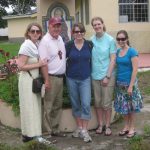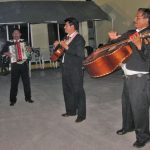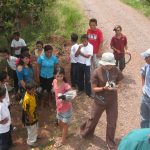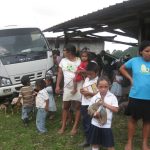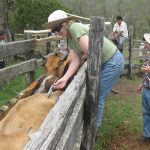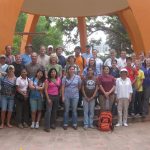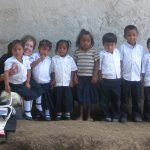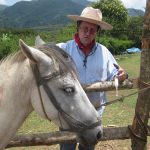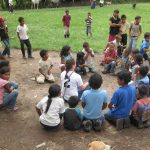Honduras Veterinary and Public Health Mission Trip Response
2010 Overview by Ashley Hagauer ’11
As a pre-veterinary student at Austin College on my first mission trip to Honduras, I wasn’t sure what to expect. Our group of 28 was from varied occupational and educational levels, including veterinarians, a pastor, teachers, ranchers and college students. Though we were an eclectic group, we all came with the same goal to help both our fellow man and animals in His name.
Our base was in Siquatepeque, about three hours from San Pedro Sula. Although unsure at first, I felt quite connected to the entire group and was grateful that we started each morning with devotionals in the park where we could share our experience in fellowship and prepare for our day of service.
Every morning we would travel to our work site in trucks. We split up into three veterinary teams and two public health teams and, over the course of four days, we vaccinated over 4,000 animals and educated over 700 school-aged children.
I was impressed by the beautiful mountains that we passed through to get to the villages. People would come from miles around in order to care for their animals. It was an amazing opportunity for hands-on experience and we worked in teams to vaccinate and de-worm animals quickly and safely. Some interesting things I learned were how to properly restrain a foal, vaccinate a pig, and identify vampire bat bites on livestock.
This mission program has been operating for 24 years and has become integrated into the lives of the people who live in the areas surrounding Siquatepeque. They all knew we were coming and appreciated our work. They were very proactive in helping their animals, getting pets and livestock to our facilities (which ranged from a soccer field to a chute on the very top of a mountain) and being hands-on while we worked with the animals. The fathers and older boys helped move not only their own cows and horses through the chute, but their neighbors’ as well. As we would de-worm and vaccinate, a volunteer would spray the animals for parasites. The children were also involved and brought their pet cats and dogs. They were quite diligent and if a scared animal got away, they would chase it and bring it back.
The livestock we treated were each marked with a large pink cross. What a sight it was to see herds of cattle, marked with a symbol of Christ as we drove across the countryside.
The public health teams spent time in local schools, teaching children though skits and activities about life skills such as protecting themselves from dehydration, how to brush their teeth, and wash their hands. The children were receptive to the teams and were happy to share and play with the members. This year was an especially big year for the public health portion of the trip because it was the start of The Owen Project, which hopes to give a XO laptop computer to each child in Honduras starting with a school in Santa Rosita. The rugged, wind-up XO was designed by an MIT professor specifically for children of the third world. Most mountain school children do not have access to textbooks, paper, and pencils. This is an amazing opportunity that will help these students have access to the greater community of the world with internet and computer programs.
This trip was pivotal in reminding me why I am interested in veterinary medicine. I hope to use my degree to educate people on the importance of maintaining their animals an there was no better place for me to see and understand the relationship that people have with their animals as their livelihood. The important balance between people and their animals was impressed upon me.
I want to extend a thank you to both Oscar Ochoa and Oscar Gross who showed us such wonderful hospitality, Bill and Lynn Campaigne for their leadership, Kevin Dellaria for leading us spiritually, my team members and all of the contributors who made this trip possible. I would also like to thank the people of Honduras who made our trip successful. I could feel God’s presence in the work we did and in the hearts of the people we served.
2011 Overview by Dr. Valerie Kirk
The veterinary public health mission to Honduras this year was my first trip abroad and my first time as a missionary. Logistically, the trip was very well-organized and well-executed; we treated 5,237 domestic animals and the public health team worked with hundreds of school children. But statistics don’t truly reveal what happened there.
The depth and warmth of the welcome I felt in Honduras was astonishing. I was very comfortable there, not feeling at all as a stranger. The language was really the only true indicator that I wasn’t at home. The patience of the Honduran people, and of my new American friends, who interpreted for me, was a blessing. Many times gestures or a few words conveyed what was necessary. The best language bridge was a smile.
Dark, curious eyes watched us as we passed on our way to the small mountain communities. Smiles and waves lighted faces when we waved greetings. Unabashed gazes of the children, watching us as we worked on their animals were the most disarming. The younger the child, the more one’s heart melted.
Constant gifts showered us through the words, smiles, and actions of the people. An older woman allowed three of us women into her home to use the toilet. Our gift of examining her rabbits seem an inadequate exchange for the trust and concern she had shown to us in allowing us entry into her home. The very best gift I received was a young teen-aged boy who intentionally sought me out while I was alone washing my hands after working the cattle and horses. In English he said, “Thank you for coming here.”
Many of the thirty-two missionaries who took this trip did not know each other when leaving the United States, but we all returned as friends. We did not preach the Gospel to the Hondurans or necessarily each other in words, but it is my hope that we, as St. Francis had, preach the Gospel to all with our actions.

